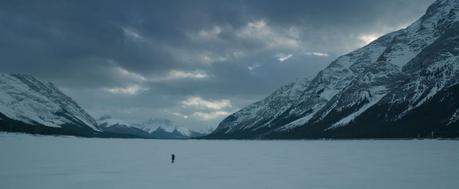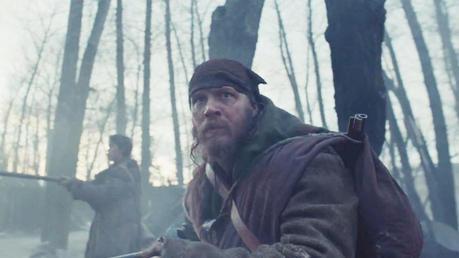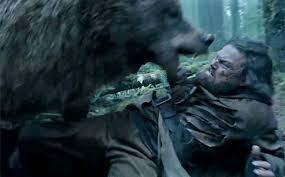The Revenant is a brutal journey across the snow-packed mountains of 1820s America. It is an adaptation of the frontier legend of Hugh Glass (Leonardo DiCaprio, forever seeking that elusive Oscar), a fur trapper who spent six weeks traveling through hundreds of miles of South Dakota wilderness “in pursuit of vengeance against the men who left him for dead after he was mauled by a bear.” His is a story which has been further embellished with each passing decade, and The Revenant further this tradition. In the hands of director and co-screenwriter Alejandro González Iñárritu, Glass has gained a tragic backstory and a half-breed son, and he’s been granted a far more cinematic climax than real life actually supplied.
In a similar way, the actual story of the making of The Revenant has grown into legend ever since THR‘s July 2015 report spilled the details of a shoot which had become, according to one anonymous crewmember, “A living hell.” Iñárritu and his cinematographer Emmanuel “Chivo” Lubezki opted to film in sequence and use only natural light, thus instantly limiting their daily window for getting the shots they wanted. As the shoot turned into a ridiculously overschedule 12-month ordeal, Tom Hardy, playing the man most responsible for leaving Glass behind and thus the villain of the piece, was forced to drop out of Suicide Squad. The budget ballooned so much the original producer was replaced mid-shoot. 15 to 20 crewmembers were either fired or quit, unwilling to continue working in sub-zero temperatures when they felt Iñárritu wasn’t taking their safety concerns seriously. DiCaprio conceded The Revenant was the toughest movie he’s ever made, even worse than the nightmarish Titanic shoot.
Throughout it all, Iñárritu maintained, “When you see the film, you will see the scale of it. And you will say, ‘Wow.'”

The technical artistry is on display from the get-go in an opening sequence which quickly transitions from an elk hunt into a fight to the death against a small army of Native Americans. Iñárritu and Lubezki recall their experimental work on Birdman…, placing the camera on a swivel and employing judicious invisible cuts to suck us into the moment, evoking Saving Private Ryan in all of its gory glory.
Afterward, the surviving members of the fur-trapping expedition predictably bicker, with the hardened grunts (led by Tom Hardy’s marble-mouthed, borderline hammy John Fitzgerald) sniping about their silver spoon Captain (Domhnall Gleeson) and wondering why their supposed expert guide, Hugh Glass, didn’t see the Native American attack coming. However, they fall in line and follow Glass’ advice until he is attacked by a grizzly bear protecting her cubs, in a harrowing scene which just keeps going, challenging you to figure out how they pulled it off. The rather principled Captain refuses to leave Glass behind, sewing up his wounds and fashioning a stretcher. Eventually, though, it becomes impractical to continue hauling Glass with them, and the Captain offers extra money to two men on the crew if they’ll stay with Glass and bury him when he inevitably dies.

It is a film which consistently tantalizes, even as you feel the need to look away from the gore or Glass’ decaying flesh wounds, but is it ultimately a hollow experience? In 1939, TIME Magazine referred to Hugh Glass as “the angriest man in U.S. history,” marveling that his “rage” at having been abandoned “provided the vitalizing will to live.” However, Iñárritu and co-writer Mark L. Smith’s version of the story somehow loses that in translation, even after giving the DiCaprio Glass far more to be angry about than simply being left for dead [Spoiler Alert: Fitzgerald kills Glass’ half-breed son right in front of him]. Anyone expecting Game of Thrones-esque moments of Glass, ala Maisie Williams’ Arya Stark, listing the names of intended revenge targets (or just the one target, in this case) before drifting off to sleep will be disappointed.
That’s partially because the devastating bear attack leaves Glass barely capable of speech. Plus, his is a mostly solitary journey. We are meant to tell through DiCaprio’s expressions that rage is his new lifeforce. A sympathetic Indian he meets along the way notices this immediately, wisely warning him that vengeance is in the hands of the gods. However, where the Indian saw a man hell-bent on revenge I saw a starving man desperate to survive. Those don’t have to be mutually exclusive, but for a film whose title refers to a dead spirit which comes back to life to terrorize the living I got more of a exhilarating man vs. nature survival vibe and less, “Vengeance shall be mine, you bastards!” (at least until the final act).
Maybe I’m missing the point, though. Iñárritu told Mens Journal that beyond being a “survival adventure story” Revenant is meant to be a metaphor, “It’s a love story between a father and his son. It’s a story about the roots of capitalism and a need to understand our environmental footprint.” That’s why DiCaprio was up there dedicating his Golden Globe for Best Actor to the indigenous peoples of the world. That’s why there is a parallel story throughout the film about a Native American Chief searching for his kidnapped daughter, using the white man’s love of material goods (i.e., animal pelts) as a means to an honorable end. That’s why Glass at one point marvels at the glorious sight of stampeding buffalo, but is later haunted by the recurring nightmarish image of a mountain of buffalo skulls (it’s not subtle).
In fact, where I expected Glass to go to sleep each night plotting his revenge he instead slips closer to death each time, frequently visited by the ghostly visage of his dead Indian wife, reminded of the words he once spoke to his son: “As long as there is a breath left in your body, you keep fighting.”
Watching Glass continue on with that fight is one of the more exhilarating cinematic experiences you can imagine; actually connecting with his journey, emotionally, is a bit more inconsistent, with the “triumph of the human spirit” portion nuzzling up awkwardly next to the reminder that this is actually a basic revenge story. That being said, The Revenant is an absolutely worthwhile viewing experience, if only for the gorgeous nature photography and perverse glee in marveling at just how far DiCaprio will go to finally win an Oscar. That makes it sounds like I didn’t like this movie. I actually did; I just couldn’t resist going out on a joke.THE CRITICAL CONSENSUS
81% – “As starkly beautiful as it is harshly uncompromising, The Revenant uses Leonardo DiCaprio’s committed performance as fuel for an absorbing drama that offers punishing challenges — and rich rewards.”
THE ABSURD

No means no, Mrs. Bear.
Um, no, Leo is not raped by a bear in this movie. Instead, he is pinned to the ground while the bear literally rips chunk out of his back.

